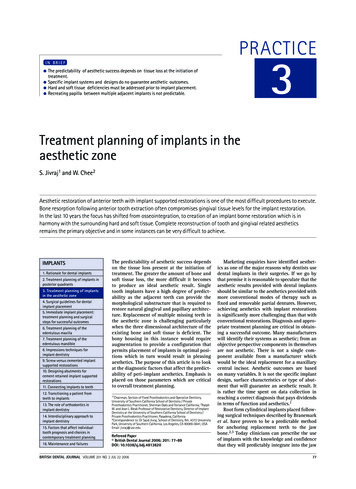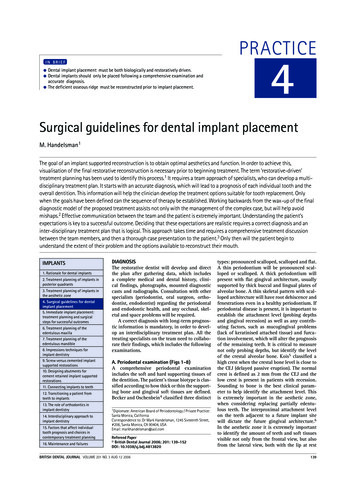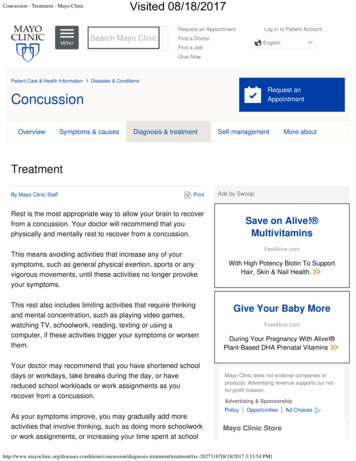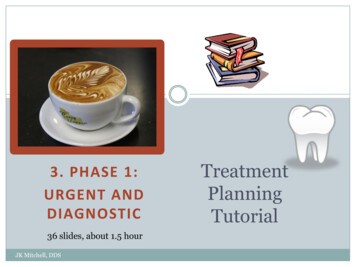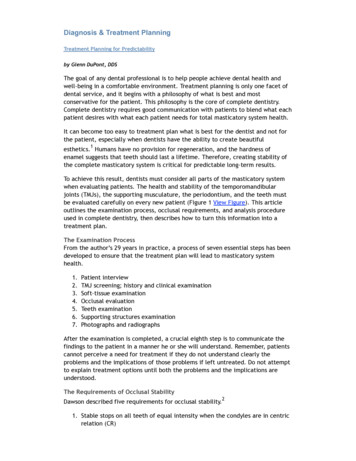
Transcription
Diagnosis & Treatment PlanningTreatment Planning for Predictabilityby Glenn DuPont, DDSThe goal of any dental professional is to help people achieve dental health andwell-being in a comfortable environment. Treatment planning is only one facet ofdental service, and it begins with a philosophy of what is best and mostconservative for the patient. This philosophy is the core of complete dentistry.Complete dentistry requires good communication with patients to blend what eachpatient desires with what each patient needs for total masticatory system health.It can become too easy to treatment plan what is best for the dentist and not forthe patient, especially when dentists have the ability to create beautiful1esthetics. Humans have no provision for regeneration, and the hardness ofenamel suggests that teeth should last a lifetime. Therefore, creating stability ofthe complete masticatory system is critical for predictable long-term results.To achieve this result, dentists must consider all parts of the masticatory systemwhen evaluating patients. The health and stability of the temporomandibularjoints (TMJs), the supporting musculature, the periodontium, and the teeth mustbe evaluated carefully on every new patient (Figure 1 View Figure). This articleoutlines the examination process, occlusal requirements, and analysis procedureused in complete dentistry, then describes how to turn this information into atreatment plan.The Examination ProcessFrom the author’s 29 years in practice, a process of seven essential steps has beendeveloped to ensure that the treatment plan will lead to masticatory systemhealth.1.2.3.4.5.6.7.Patient interviewTMJ screening; history and clinical examinationSoft-tissue examinationOcclusal evaluationTeeth examinationSupporting structures examinationPhotographs and radiographsAfter the examination is completed, a crucial eighth step is to communicate thefindings to the patient in a manner he or she will understand. Remember, patientscannot perceive a need for treatment if they do not understand clearly theproblems and the implications of those problems if left untreated. Do not attemptto explain treatment options until both the problems and the implications areunderstood.The Requirements of Occlusal Stability2Dawson described five requirements for occlusal stability.1. Stable stops on all teeth of equal intensity when the condyles are in centricrelation (CR)
2. Anterior guidance in harmony with the border movements of the envelope offunction3. Disclusion of all posterior teeth in protrusive movements4. Disclusion of all posterior teeth on the nonworking (balancing) side5. Disclusion or noninterference of all posterior teeth on the working side, witheither the lateral anterior guidance or the border movements of the condyleIn establishing a stable occlusion, anterior guidance assumes the key role. Theanterior teeth are better able to resist lateral stress than the posterior teethbecause of their mechanical position in relation to the TMJ fulcrum and the muscleforce.Assessing Worn DentitionThe worn dentition, especially worn anterior teeth, presents a great challenge. Inthese cases, the goal is to create atraumatic, comfortable, stable occlusion andstill be able to achieve optimal esthetics. The author’s 29 years of experiencetreating patients with worn dentition has resulted in some important observations.It is very helpful to adhere to the rules of programmed treatment planningprecisely, applying each step in sequence.Worn teeth may (or may not) have deflective interferences.Wear usually does not cause a loss of vertical dimension of occlusion (VDO).The VDO usually can be slightly increased with comfort and stability.Posterior teeth cannot wear from attrition in an ideal occlusion. Therefore,treatment must involve a stable, repeatable, CR starting point combinedwith anterior guidance in harmony with the posterior disclusion in everyexcursion. Do not steepen or restrict the envelope of function. A shallowenvelope of function seems to provide a lessening of muscle activity and amore stable result. The disclusion provided by the envelope of functionneeds to be combined with a shallow curve of Spee and curve of Wilson toprovide posterior disclusion. Attritional wear occurs when the teeth are inthe way of function.Test everything out in provisionals.Analysis with Mounted Diagnostic CastsThe planning for definitive occlusion and esthetics begins at the diagnostic wax-upstage. Mounted casts and articulators should be used to minimize errors in basicgeometric principles. For example, if the occlusion is opened on one axis and thenclosed on another axis, it will not return to the same position.Working out ideal function and esthetics on study casts can provide great value.Study casts allow for clear patient communication as well as communication withspecialists. They help in efficient sequencing of treatment for predictability,profitability, and especially confidence during the consultation with the patient.Treatment Planning Model and Photographic Flow SheetStep 1: Choose Condylar PositionBased on the TMJ screening and occlusal evaluation, choose a condylar position:maximum intercuspation (MI), CR, or treatment position. If the case is an MI case,the models should be mounted in MI; if a CR case, the models should be mountedin CR; and if a treatment position is used, the models should be mounted for finalstudy in that position.
Step 2: Go Tooth by ToothUsing the data from the casts, soft- and hard-tissue examinations, supportingstructures examination, and the photographs, mark the hopeless teeth, thequestionable teeth, and the teeth that need to be restored (crowned or onlaid)because of weakness or breakdown. At the Dawson Academy, a specific series ofphotographs are recommended to help in the esthetic and functional evaluation aswell as patient acceptance (see Pace).Step 3: Evaluate Maxillary–Mandibular Occlusal Plane, Facial Asymmetries, andSkeletal AbnormalitiesUsing photographs (full-face, profile, and smile views) and mounted casts, envisionthe result functionally and esthetically.Step 4: Choose Vertical and Horizontal Position of Mandibular Incisal EdgeUsing the casts and photographs (rest, “E” position, smile from three views,full-face, profile smile, tipped up anterior occlusion view and tipped-down smile)as references, wax or reposition the teeth into an ideal position. Then, confirmthat an acceptable ideal position has been accomplished.Step 5: Choose Vertical and Horizontal Position of Maxillary Incisal EdgeUsing the photographs (rest, “E” position, smile from three views, full-face,profile smile, and tipped-down smile), wax or reposition the teeth into an idealposition. Again, confirm that an acceptable ideal position has been accomplished.This is a key step when cosmetic concerns are driving the case.Step 6: Choose VDOAfter the working VDO is decided, choose a method of equilibration: reductiveequilibration (balance casts back to original vertical dimension by removal ofinterferences) or additive equilibration (add to posterior teeth as a restorative ororthodontic process) or a combination of both. This will help to provide ananterior guidance that is as shallow as possible and still provide posteriordisclusion and the desired esthetics. Remember, lengthening anterior teeth oftenwill steepen the guidance and infringe on the envelope of function. Look forevidence of horizontal parafunction (anterior wear or mobility) on clinical analysis,photographs, and casts that will indicate that the changes made are not beingaccepted by that patient’s system.Step 7: Provide Equal-Intensity StopsIf reductive equilibration is the choice, balance all premature interfering contactsto return the pin to contact with the anterior guide table and to establish uniformcentric stops all the way around the arch, including the anterior teeth. If additiveequilibration is the choice, wax the posterior teeth (one or both arches) to provideuniform anterior and posterior stops.At this point, the case should have uniform centric stops with a good cusp–fossarelationship on each posterior tooth and a stable holding contact on each anteriortooth. If not, consider sawing and moving the tooth, or waxing to restore theteeth. Be sure to create ideal lower anterior incisal edge position (Step 4), as wellas ideal maxillary lingual contour through shaping or waxing.Step 8: Eliminate Balancing and Working InterferencesFirst, mark the balancing and working interferences with a red ribbon by unlocking
the CR lock and guiding the cast in left, right, and protrusive excursions. Then,lock the cast back in CR, marking the centric stops with a black ribbon. Next,eliminate all the red skid marks that are not superimposed directly over the blackcentric stops which should be established on all posterior teeth. Finally, whatremains should be the centric stops on the posterior teeth and red guiding markson the anterior teeth (lines on the front, dots in the back).Step 9: Harmonize Anterior GuidanceHarmonize the anterior guidance to establish smooth, gliding left, right, andprotrusive movements of the casts. It is desirable to share this movement with asmany anterior teeth as possible.Consider waxing the teeth to create an ideal anterior guidance, being careful notto constrict (steepen) the envelope of function (Figure 2 View Figure). Theanterior teeth should be in harmony with the functional matrix created by the lips,the tongue, and the envelope of function.Step 10: Final Functional and Esthetic CheckAfter the anterior guidance has been harmonized, recheck for any balancing,working, or protrusive interferences and eliminate them. Create smooth anteriormovements.Try to visualize the final result and decide, through model work and photographicanalysis, if it would be completed most successfully through equilibration, toothrepositioning (orthodontics), restorative dentistry, or orthognathic surgery.Regardless of the treatment option, the goal is always to do the least amount ofdentistry to provide the patient with the requirements of occlusal stability andsatisfy the elective esthetic desires of the patient.Treatment SequencingWhen treatment sequencing for efficiency, predictability, and profitability, thetreatments can be organized into phases.Phase I TreatmentEliminate pain and/or abscesses, using splint therapy where applicableAddress emergency concerns of patientInitial scaling and root planing if neededProvide home-care instructions if neededImplement caries-control treatments if neededRefer to specialists for evaluation to get the “whole picture”Second consultation if neededPhase II TreatmentSplint therapy for treatment positionEquilibrationReferral to specialists for treatment (orthodontist, oral surgeon,periodontist, endodontist)Provisional restorationsRe-evaluate to be sure TMJ, periodontal, orthodontic, or other work is completedsatisfactorily. Discuss any final esthetic considerations with the patient. Using theabove 10 steps, re-evaluate to ensure the provisionals are approved by the dentist
and the patient.Phase III TreatmentPhase III is the restorative phase. It is ideal to finish in the order below. This orderallows for the easiest way to ensure predictability, especially as it relates tocommunication with the laboratory. It also allows for reassessment of function,ideal cusp design, and the necessary room for restorations at each step.1.2.3.4.Mandibular anteriorsMaxillary anteriorsMandibular posteriorsMaxillary posteriorsCase ExampleThese principles were used in the treatment of a patient with severe wear and ananterior deep overbite (Figure 3 View Figure and Figure 4 View Figure). The TMJswere stable and, to treat very conservatively, the author treated the patient ather existing VDO. The most important step in any treatment is to work out everydetail on the study casts (Figure 5 View Figure). The diagnostic wax-up then isused for discussion with the patient, creation of preparation guides (Figure 6 ViewFigure), and communication with any specialists, in this case the periodontist.Therefore, equilibration was used to provide equal intensity centric stops on theposterior teeth. Periodontal treatment by Dr. Ron Kobernick was used to level thegingival height and remove the maxillary buccal exostosis (Figure 7 View Figure).The anterior teeth then were restored with all-ceramic restorations (Rick Sontag,CDT, Center Dental Lab), providing definitive centric stops and opening theenvelope of function. The patient’s deep overbite and incisal edge positions weremaintained to fit her functional matrix (Figure 8 View Figure and Figure 9 ViewFigure). Therefore, predictability, stability, and ideal esthetics were developed tosatisfy her needs.ConclusionA comprehensive examination that includes every aspect of the stomatognathicsystem combined with the application of the information gathered into aconservative treatment plan represents the most important and criticalcomponents in creating a predictable, functional, and esthetic result withlong-lasting stability. Following the specific steps outlined can help cliniciansachieve these results predictability, efficiently, and profitably in any type ofrestorative case.References1. Miller L. Symbiosis of esthetics and occlusion: thoughts and opinions of a masterof esthetic dentistry, J Esthet Dent. 1999;11(3):155-165.2. Peter E. Dawson, Functional Occlusion From TMJ to Smile Design. St. Louis, MO:Mosby Elsevier; 2006.
FIGURE 1 The key components of themasticatory system: TMJs, supportingmusculature, periodontia, and teeth.FIGURE 2 Ideal anterior guidance. Notethat the anterior teeth are in harmonywith the functional matrix created bythe lips, the tongue, and the envelopeof function.FIGURE 3 Preoperative smile view.FIGURE 4 Preoperative full-face view.FIGURE 5 The diagnostic casts.FIGURE 6 The preparation matrix.
FIGURE 7 The final preparations.FIGURE 8 The final preparations.FIGURE 9 Postoperative full-face view.About the AuthorGlenn DuPont, DDSPrivate PracticeSt. Petersburg, FloridaPrint article
dentistry to provide the patient with the requirements of occlusal stability and satisfy the elective esthetic desires of the patient. Treatment Sequencing When treatment sequencing for efficiency, predictability, and profitability, the treatments can be organized into
